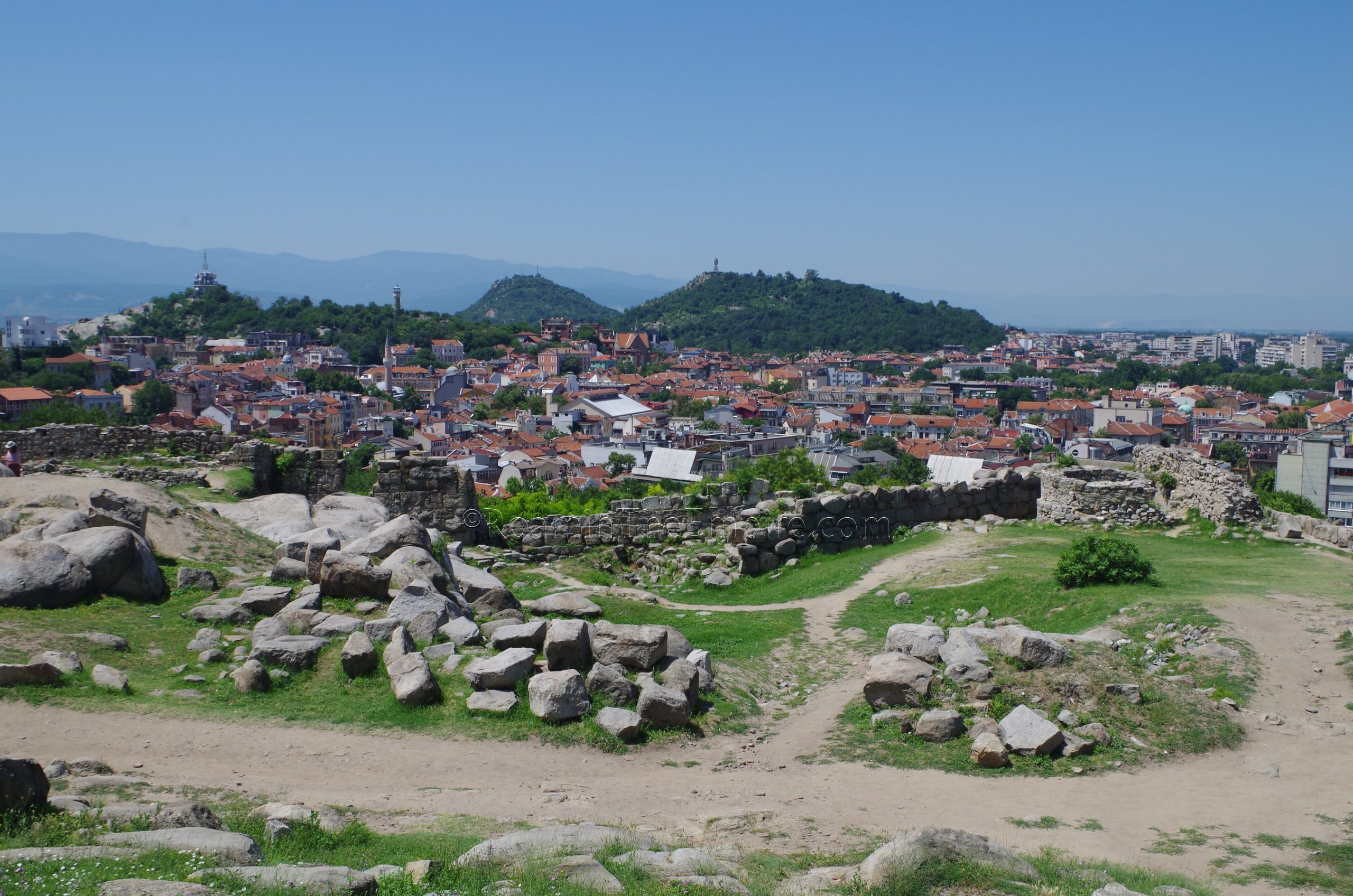
The modern Bulgarian city of Plovdiv, most commonly known in antiquity as Philippopolis among a host of other names, is sometimes cited as being the oldest city in Europe, with habitation in the area dating back to the 6th millennium BCE. Perhaps part of what earned it the shared title of European Capital of Culture in 2019 (along with Matera, Italy). It’s position along the Hebrus (now the Maritsa River) made it particularly important site in the control of the route between Macedonia and the Póntos Áxeinos, the Black Sea. The first major settlement here seems to have been a Thracian town of the Bessi called Eumolpias on the Nebet Tepe hill in the mid-2nd millennium BCE. Eumolpias was briefly under the control of the Persians in the early 5th century BCE, but then became part of the Odrysian Kingdom in the mid-5th century BCE, when it seems to have been called Pulpudeva and may have served as the royal capital of the kingdom.
Around 342 BCE, portions of a now declining and fragmented Odrysian Kingdom was conquered by Philip II of Macedon, including Pulpudeva, which was re-founded by Philip II as Philippopolis. Apparently the core of Philip II’s new settlers at Philippopolis were of questionable moral character, which earned the town the unpleasant nickname of Poneropolis; City of Crooks, though some primary sources claim that nickname belonged to different cities. The conquered Odrysian territories gained some sort of nominal independence as client states of Macedonia in the years following Philip II’s campaigns. Celtic migrations into the area resulted in the siege and sack of Philippopolis in the early 270’s BCE.
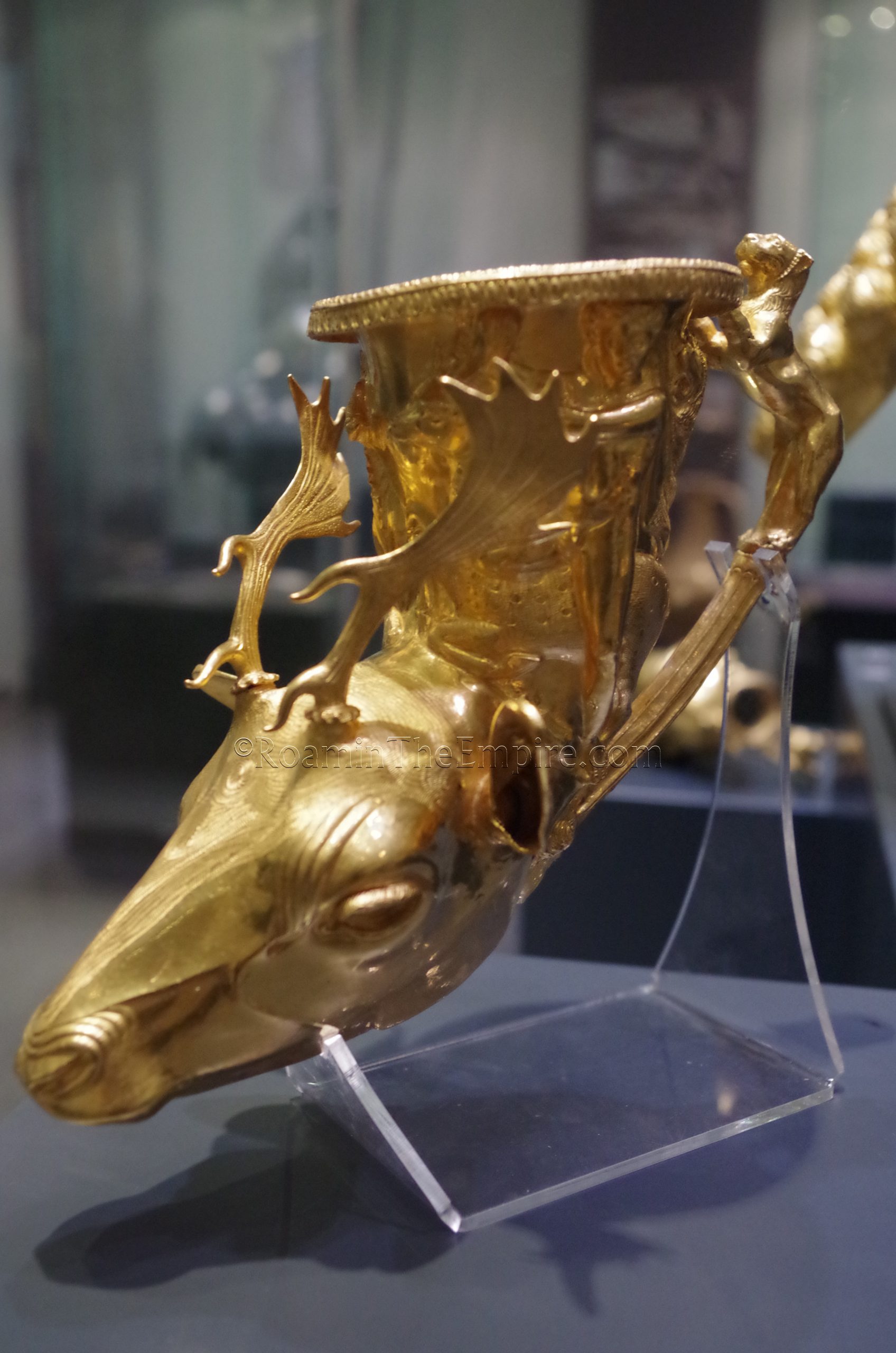
A series of regional conflicts in the wake of the death of Alexander the Great lead to power struggles over the area and shifting loyalties. Philippopolis was once again occupied by the Macedonians under Philip V in 183 BCE, but it was retaken by the Odrysian Kingdom not long afterward. Subsequently, Odrysian Kingdom first supported Macedonia in its war against Rome, but later allied themselves with Rome, ensuring some degree of peace for a time after the Romans began extending the hegemony over the region. Following the establishment of the Roman province of Macedonia, there were intermittent conflicts with the Thracians, and specifically the Bessi, who were defeated by the Romans in a battle on the frozen Hebrus in the late 2nd century BCE.
Philippopolis was occupied by Marcus Terentius Varro Lucullus in 72 BCE as part of his campaign against the Bessi while acting as governor of Macedonia. Roman withdrawal shortly thereafter returned it to Thracian control. Conflict continued, but in 20 BCE, Thrace was made a client kingdom of Rome. Philippopolis was besieged during revolt against the Thracian king Rhoemetacles II in 21 and 26 CE. Thrace was annexed by Rome following the death of Rhoemetacles II’s successor, Rhoemetacles III in 46 CE and it became the province of Thracia. During this time, Philippopolis was also called Trimontium by the Romans, a reference to the three hills at the center of the urban area.
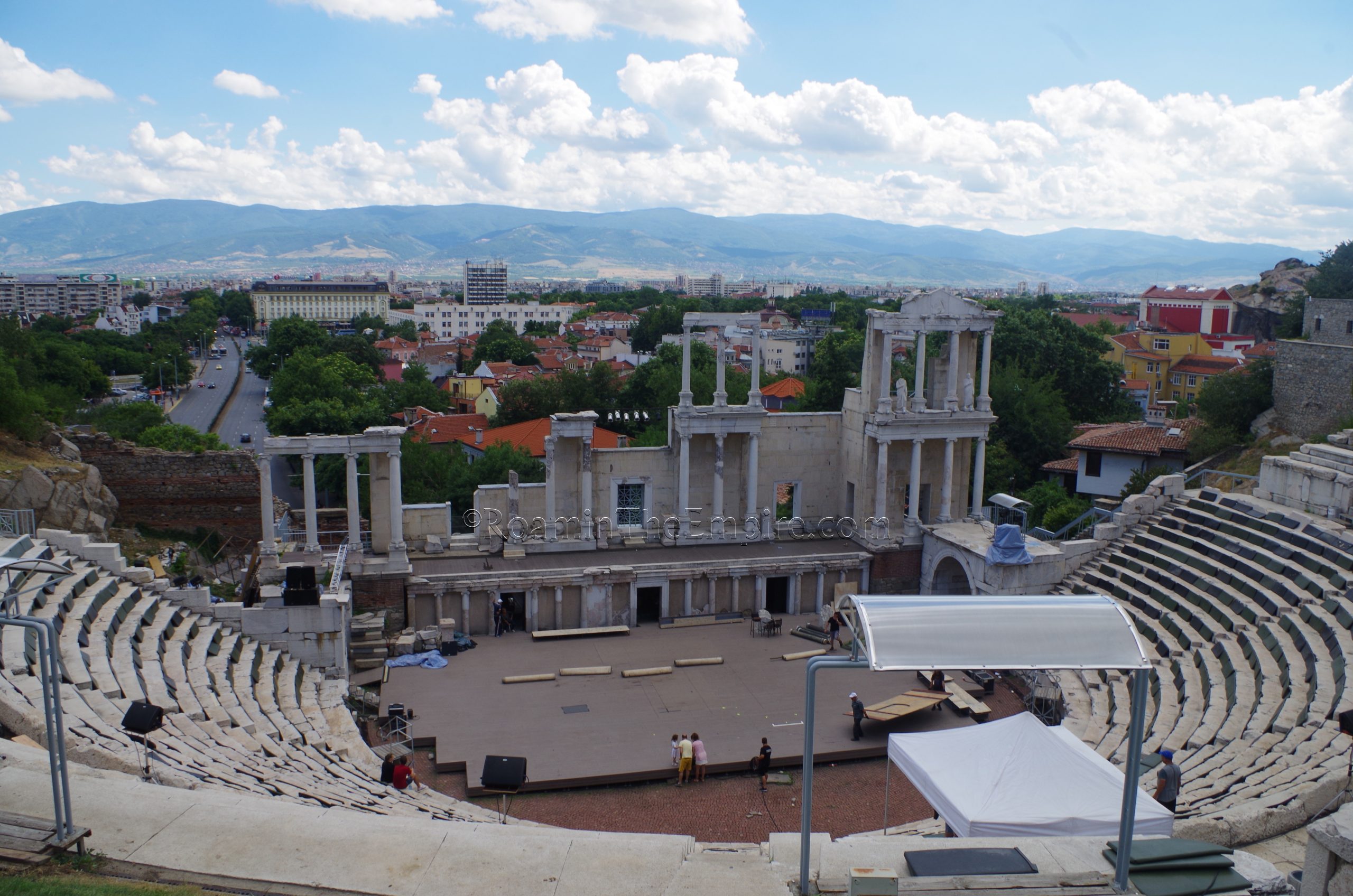
Though Philippopolis was perhaps the most important city in Thracia, it was not made the provincial capital. It did host a provincial Thracian assembly, the koinon, though. By the late 1st century CE, Philippopolis was granted municipium and under Domitian was given the title of metropolis and the ability to mint coins. Building projects under the Flavian emperors earned it the title of Flavia Philippopolis. The 1st century CE also saw the construction of the Via Militaris, which ran through the city. Under Philip the Arab in the mid-3rd century CE, Philippopolis was given colonia status, had its walls reinforced, and perhaps around this time became the provincial capital of Thracia. Elagabalus bestowed the title of Neokoria of Thracia on the city for its temple to the living emperor, possibly during his visit in 218 CE, but no later than 220 CE.
In 250 CE, the Gothic king Cniva led an army across the Danube attacking several cities before moving on to Philippopolis. Philip the Arab’s successor, Trajan Decius, attempted to intervene but was defeated at Augusta Triana (modern Stara Zagora). Cniva then laid siege to Philippopolis. The provincial governor, Titus Julius Priscus was among those at the city and either after the betrayal of the city to the Goths, or perhaps in return for allowing the city to fall to the Cniva, declares himself emperor with the Gothic support. In the aftermath, the city suffers significant destruction and hundreds of thousands of Philippopolis’ citizens were slaughtered. It was once again besieged by Germanic forces around 268 CE, though managed to hold out against them.
Though Philippopolis recovered from the destruction in the mid-3rd century CE, fire once again ravaged the city sometime in the late 3rd century CE. It was sacked by Attila in 441 CE and again by Theodoric Strabo in 473 CE.
Getting There: Plovdiv is the second largest city (by a slim margin over Varna) in Bulgaria. As such, it’s relatively well connected via other major centers in the country by rail and bus. There is pretty regular daily service (average of one train an hour for much of the day) between Sofia and Plovdiv. It takes between 2.5 and 4 hours depending on the train. Prices range between about 8 Lev for 2nd class on the slower trains and 11.50 Lev for 1st class on the faster trains. Bus travel is pretty much the same time and price range. I arrived by train, but the train station is a little bit outside of the historic center, which necessitated a short local bus ride in. Once in the center, though, it’s pretty easy to get around on foot. There is an airport for Plovdiv, but it only has service from London and seasonally from Russia and Israel.
The archaeological remains of ancient Philippopolis are quite extensive and it’s difficult to pick out a good place to start from. It’s also very much more than a day trip. There’s only a couple stops that might require more than a half an hour or so; while one could theoretically pack most of the things into a day, it would be a very full day.
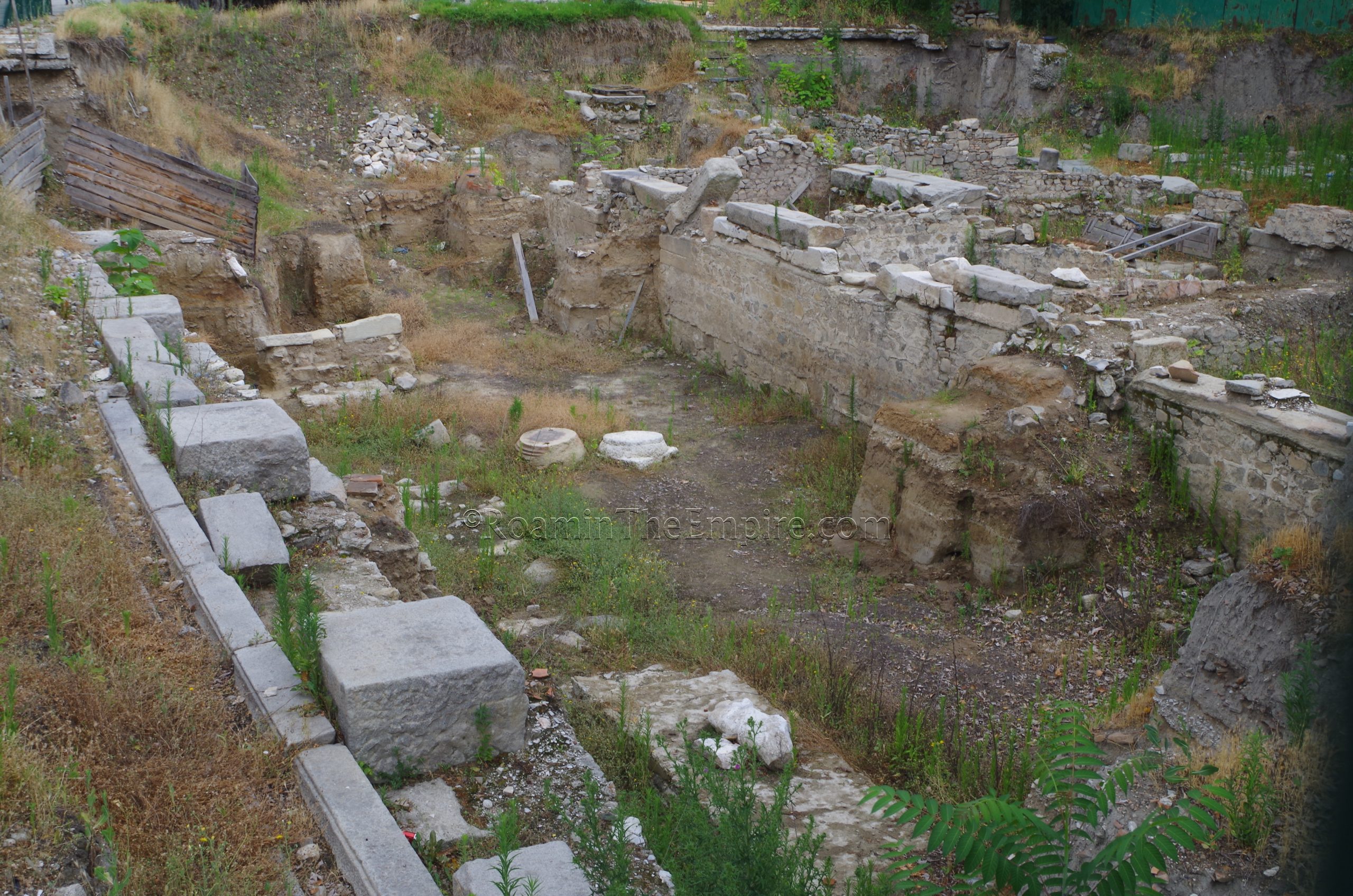
With that, an arbitrary starting point could be the area of the forum of Philippopolis. The forum is located in the vicinity around pl. Tsentralen, appropriately enough, the ‘central square’. The central post office for Plovdiv is located pretty much right in the middle of all of the remains. A few of the surrounding businesses in the square also bear a “Trimontium” in their names. The forum was originally part of the 1st century CE urbanization program of the city, probably under the reign of Vespasian. There are a few points at which the remains of the forum and adjacent buildings can be seen.
First there are some remains from the forum in the northwestern corner of the square, opposite the main entrance to the post office. When I visited in 2017, it was excavated but still seemed to be in an unfinished state and was inaccessible (though it could be viewed from the square. In the summer of 2019, there were active excavations and improvements, so much so that it wasn’t much to look at in comparison to the previous visit, many features were obscured by the ongoing construction. The works have since apparently finished and it is now a park with a stretch of road and a few reconstructed columns from the forum portico, as well as some adjacent buildings. There is no admission or gated access, so one should theoretically be able to visit at any time.
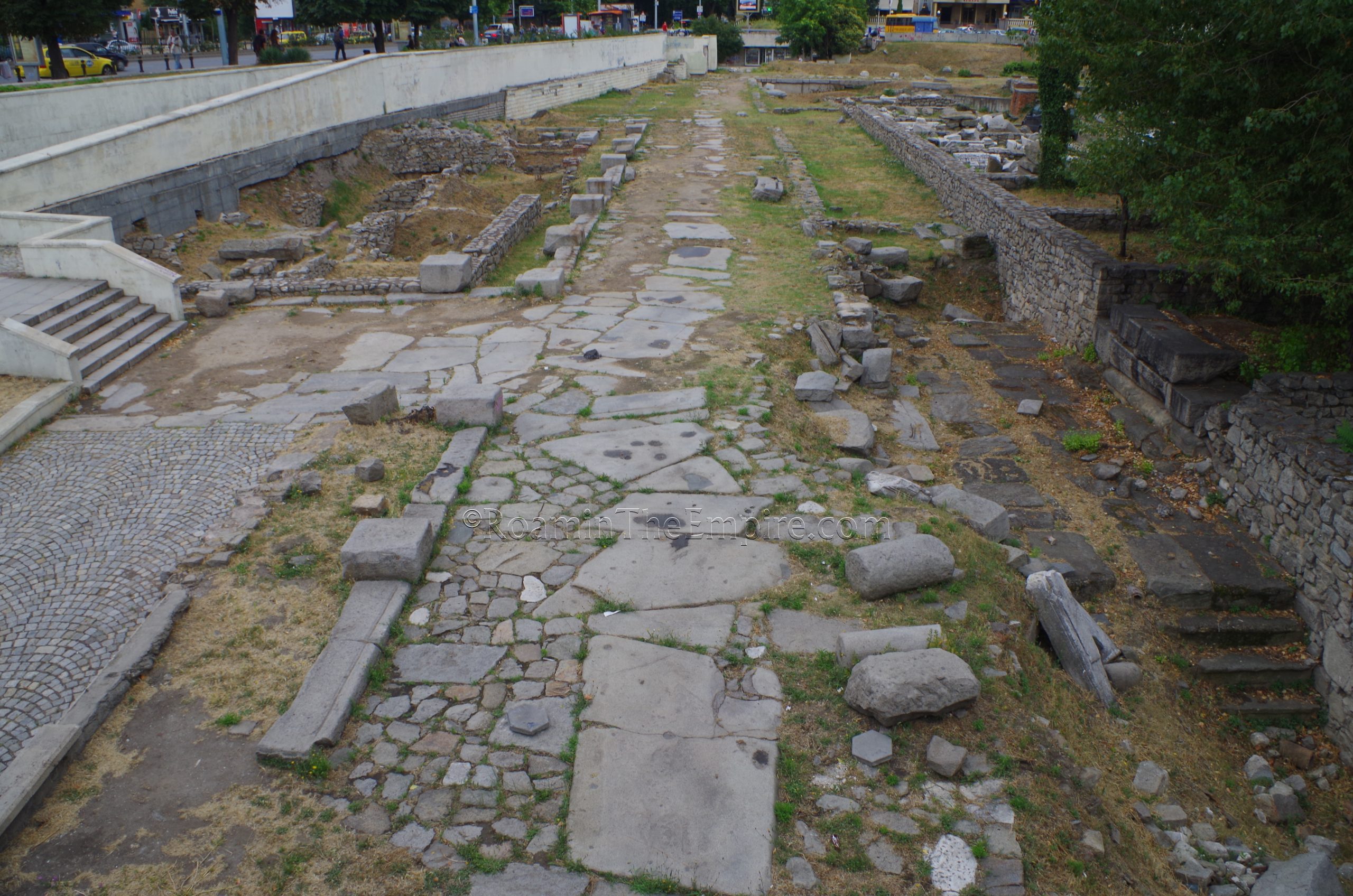
The biggest portion of the forum exposed is on the east side of the post office, between the building and the major thoroughfare, Boulevard Tsar Boris III Obedinitel. Like the previous bit of the forum, this one is also essentially an open access park with no admission. It is sunken below the current ground level of the surroundings and there are access points on the northeast corner off the street, and at the southeast corner.
What remains in this park are significant sections of the southern and eastern part of the forum. Only a very small portion of what would have been the interior colonnade of the portico that surrounded the forum is visible; the post office takes up a significant amount of the area that actually constituted the open surface of the forum. What is more visible here are the interior rows of tabernae that would have faced onto the portico that surrounded the forum. The decumanus maximus and cardo maximus then run along the outside of these shops, intersecting at the southeast corner of the forum. Additional constructions on the exterior of the roads, probably more tabernae, are also visible in some places, particularly along the east side of the cardo maximus.
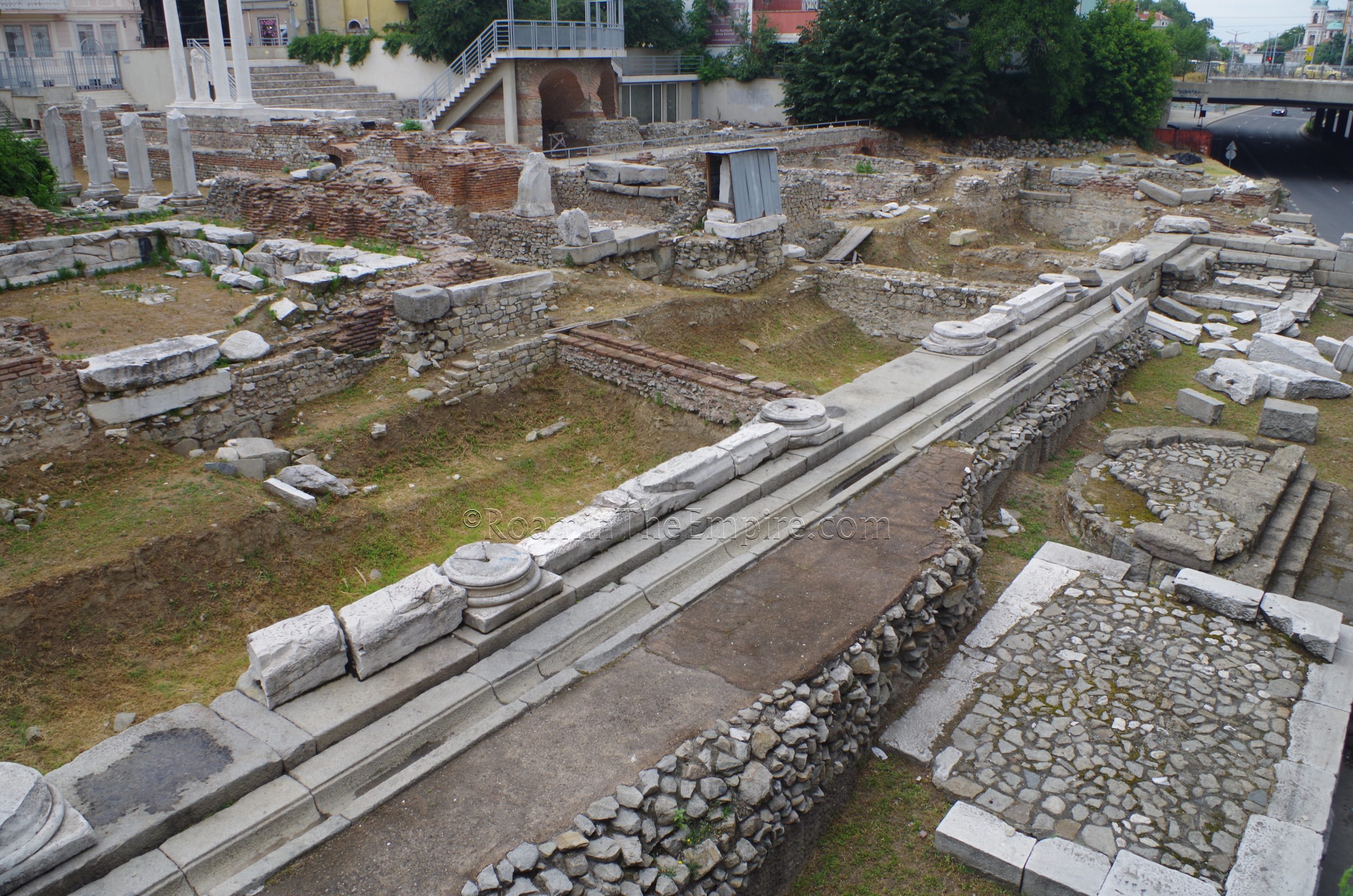
In an isolated portion at the southeast corner of the form, separate but accessible form the rest of the park (through a sketchy tunnel), though it can also be accessed and visible from the ground level, is a small stretch of one incarnation of the city walls, along with a small portal in what would have been a southern extent of the city walls.
The final visible bit of the forum is essentially the northern extent. Unfortunately there is no access to this area, which includes the odeon. The best place to view it is from the open area just to the north of the post office, between the building and Boulevard Knyaginya Maria Luiza, which is sunken significantly below the level of the square. This point is also higher than the remains of the forum and offers a pretty good view over the road and into the forum area. There is a point along ul. General Gurko, just north of the odeon that also offers a small peak at the odeon and surrounding area, presumably where one would enter if the area was accessible. There is also a small informational sign there about the odeon in English and Bulgarian.
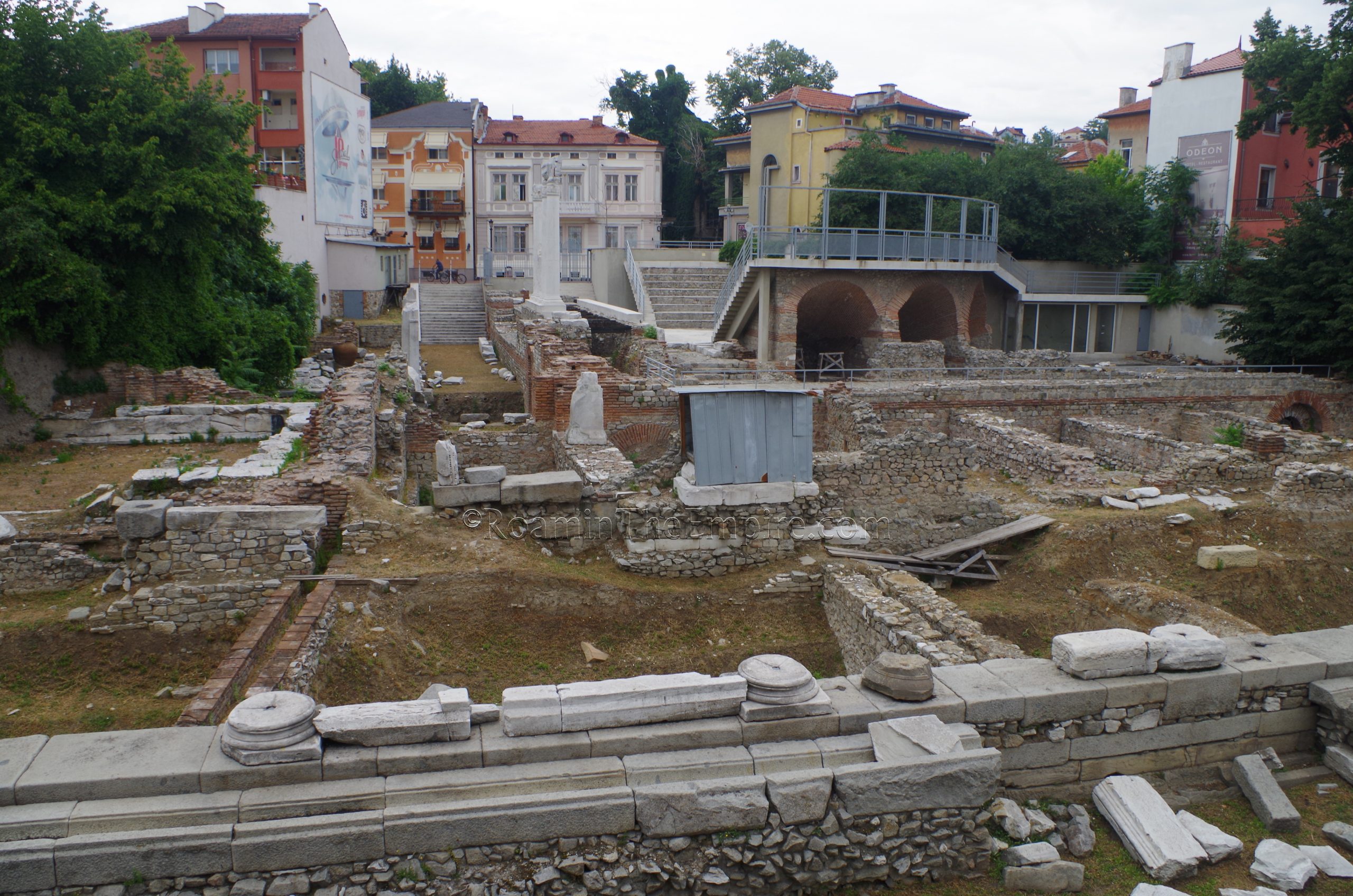
The foreground of the remains (when viewing from the post office area) are again the tabernae that looked out onto the portico that ran along the north side of the forum. The northeast corner of the colonnade for the portico is also distinguishable among the remains. In addition to the odeon, a library and treasury were apparently among the public buildings located in this area, though. There’s not much in the way of interpretation of the remains, though there is a larger building that would have fallen roughly in the center of the row of tabernae along the north side of the portico, perhaps the library. Behind the library, and only visible from the viewpoint near the odeon, is a small portico.
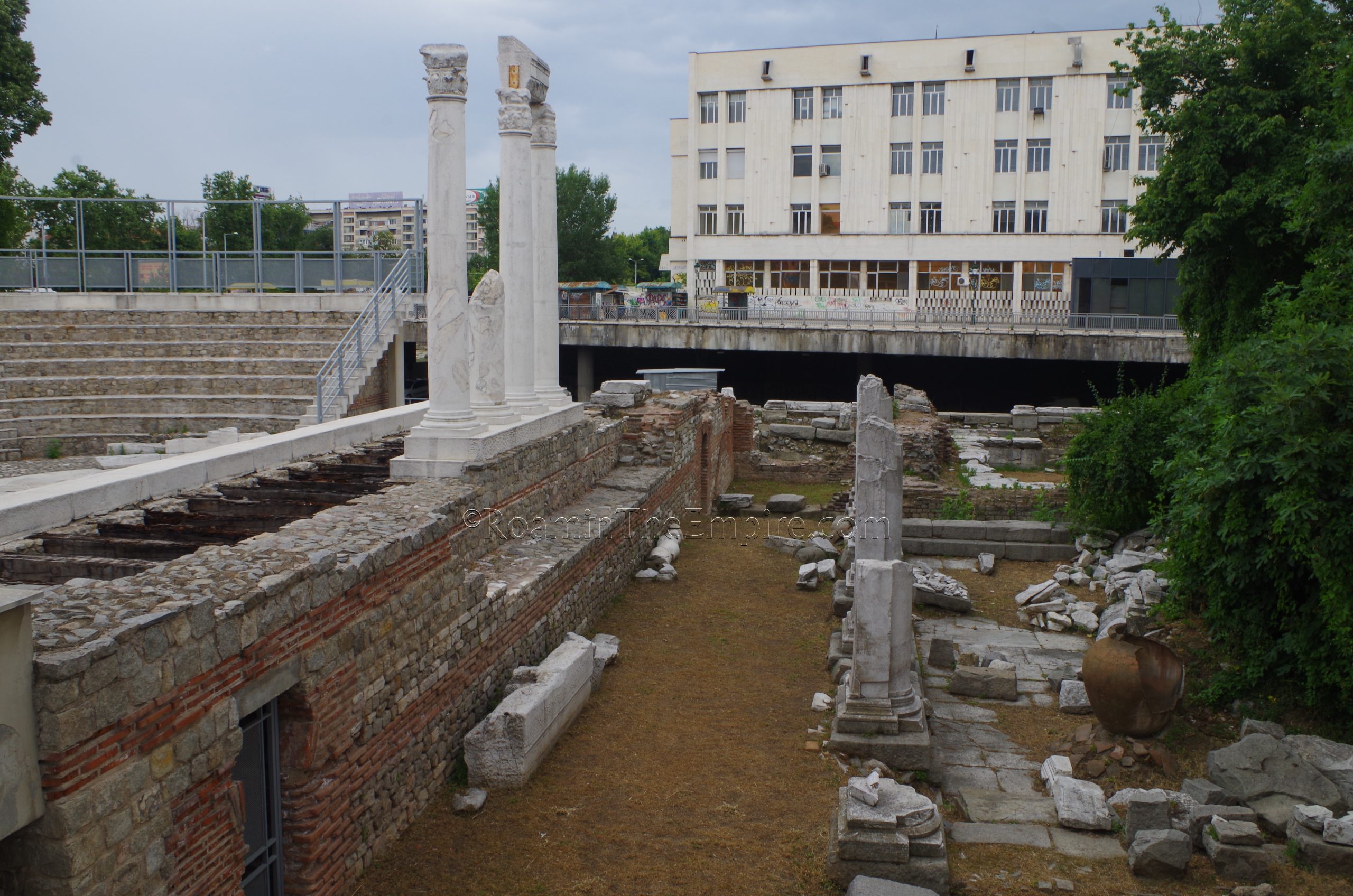
The odeon is pretty heavily reconstructed. The location seems to have originally served as the site for the bouleuterion in the Hellenistic city, and that it was later converted into the odeon. The initial phase of construction of the actual odeon was in the 1st century CE and underwent a series of renovations through to the 4th century CE, when it was heavily damaged in the invasions and sacks of the subsequent years. It was further damaged in heavy spoliation of the forum area during the 10th through 12th centuries CE. Since Philippopolis had no amphitheater, it is theorized that the other entertainment venues in the city hosted gladiatorial events. There is some evidence to suggest the odeon was among the venues utilized, along with the theater and circus. In the medieval period, the northern area of the forum and odeon was used as a necropolis.
Continued in Philippopolis Part II
Sources:
Ammianus Marcellinus. Rerum Gestarum, 21.15, 26.10.4, 31.5.17.
Burrell, Barbara. Neokoroi: Greek Cities and Roman Emperors. Leiden: Brill, 2004.
Diodorus Siculus. Bibliotheca Historica, 16.71.2.
Livy. Ab Urbe Condita, 39.53.
Pliny the Elder. Historiae Naturalis, 4.18.
Ptolemy. Geographika, 3.11.
Tacitus. Annals, 3.38.
Topalilov, Ivo. (2014). An Aspect of the Political Propaganda in Philippopolis, Thrace, During II C. AD. In Studia Hungaro-Bulgarica III. Sumen-Szeged.
Valeva, Julia (ed.), Emil Nankov (ed.), and Denver Graninger (ed.). A Companion to Ancient Thrace. West Sussex: Wiley Blackwell, 2015.


